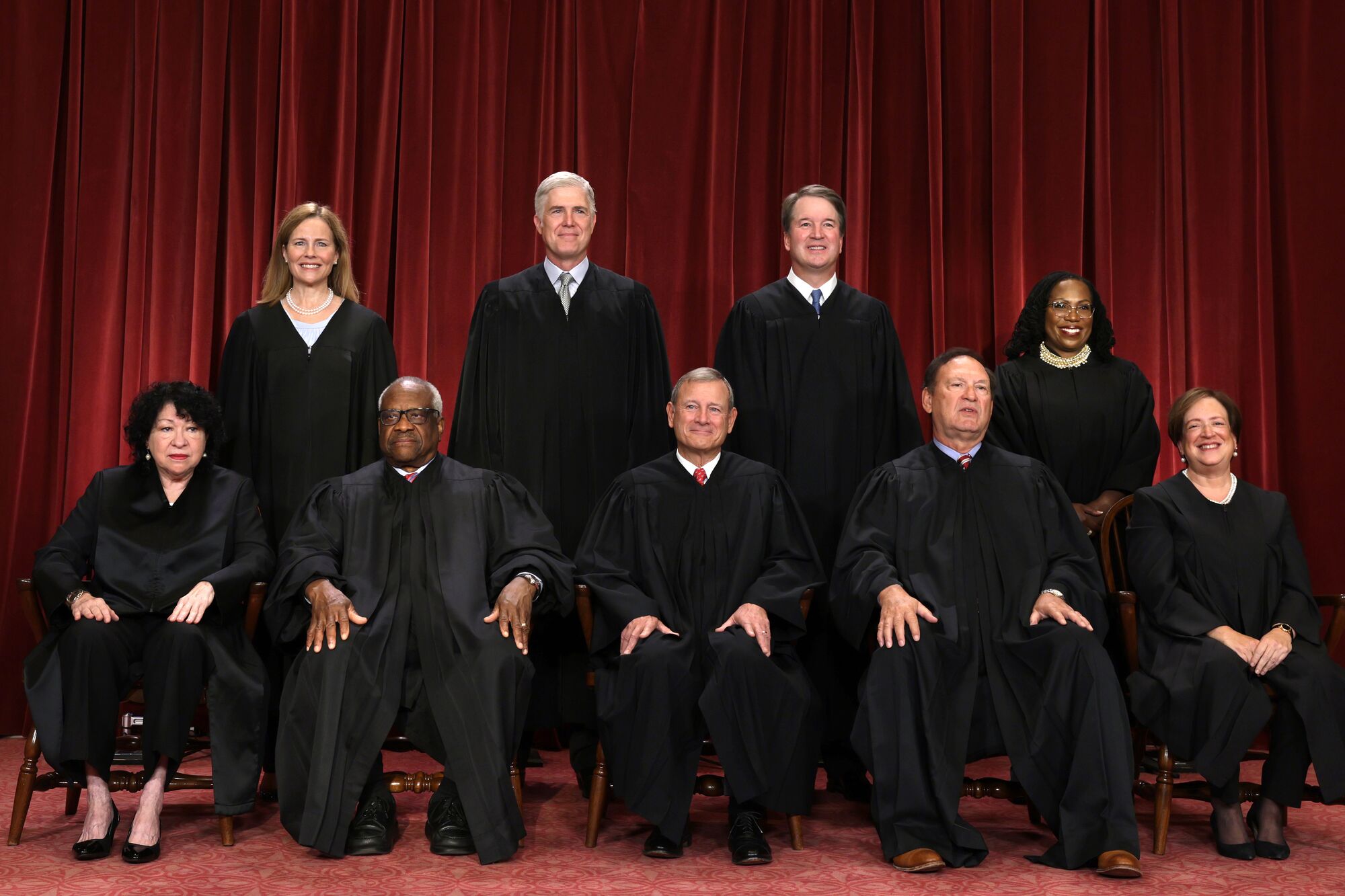Here’s What to Expect From the Supreme Court This Term
Recent environmental rulings from the Supreme Court’s conservative supermajority have revealed a dangerous agenda, but we still have strong legal tools to protect people and the planet.

(Illustration by Rob Chambliss)
Thanks to unlucky timing and scorched-earth politics, Americans are now governed by the most conservative Supreme Court of the United States in modern history. Among its distressing actions, the six-justice supermajority is aggressively pursuing an anti-environment agenda driven by, among others, the nation’s biggest polluters.
Two recent decisions showcase the current Court’s attitude to environmental protections. In West Virginia v. EPA, decided in June 2022, the Court struck down the Obama-era “Clean Power Plan” (CPP). The CPP had aimed to reduce carbon dioxide emissions from power plants by requiring them to shift towards renewable sources. The Court held that the Environmental Protection Agency (EPA) couldn’t do this because the Clean Air Act only allows the EPA to mandate pollution controls that plants can implement “inside the fenceline” of the facility.
Then in Sackett v. EPA, decided in May 2023, the Court held that the EPA could not require an Idaho couple to obtain a permit before filling in wetlands on their property. Sackett reversed prior decisions by holding that the language of the Clean Water Act does not extend to protect wetlands unless they are “as a practical matter indistinguishable” from surface waters.
I have watched the Supreme Court carefully from the days when I clerked for Justice Sandra Day O’Connor. And like all of Earthjustice’s more than 200 attorneys, I pay special attention to the Court’s decisions on environmental and administrative law so that we can shape our case selection and legal strategies accordingly. (Skip to the bottom of this article to learn how Earthjustice is leading in this new legal landscape.) What’s striking to me right now is not just the direct consequences of Sackett and West Virginia v. EPA, but the reasoning behind these decisions.
The Congresses that wrote bedrock laws like the Clean Air Act and Clean Water Act used sweeping language to describe ambitious environmental goals, and then gave agencies broad authority to achieve them. The visionaries who wrote and passed those laws knew that legislatures can’t cover every detail, and that scientists, not politicians, should be the ones identifying and addressing new problems as they emerge. Environmental protection in the U.S. therefore depends on the understanding — settled since the New Deal — that Congress has robust regulatory power, and that Congress can broadly delegate that power to expert agencies like the EPA.
Sackett and West Virginia v. EPA chip away at both of those assumptions. In both cases, the Court’s conservatives expressed concern about the scope of Congress’ authority to regulate private activity and the extent to which Congress can delegate that authority to federal agencies. And in both cases, conservatives went out of their way say that federal environmental regulations are among the worst examples of “big government gone wrong.”
It’s not surprising to me that the Court’s conservatives are so openly hostile to the work of federal agencies, and to environmental regulations in particular. Their philosophy is the product of a decades-long campaign by polluting industries to capture our federal courts. Those industries spent many years and many millions lobbying Congress to rewrite our foundational environmental laws and asking presidents to defang agencies like the EPA. Those efforts largely failed because Americans want elected officials to protect the environment. So the industries — primarily the oil and gas industry — turned to nurturing conservative and anti-government legal thinkers, then pushing to get them on the federal bench. They wanted courts to deliver what the political branches had not: sweeping deregulation. Put simply, the Justices of our Court were specifically chosen for their hostility to the federal “administrative state” that regulates private industry.
Sackett and West Virginia v. EPA are therefore part of a broader campaign to reshape the federal government in ways that limit its ability to regulate in the public interest. The Court has questioned assumptions about federal regulatory power not just in the environmental context, but also in recent cases challenging Obamacare and COVID-19 vaccination requirements. And this year it struck down President Biden’s decision to cancel certain student loans using the same made-up “major questions doctrine” that it applied in West Virginia v. EPA.
Next term’s concerns
The Court has already set itself up to continue its campaign next term, which starts in October. Several of its new cases will have huge implications for federal agencies.
The main case we are watching is Loper Bright Enterprises v. Raimondo. In that case, a fishing company is challenging a fishery monitoring program supervised by the National Marine Fisheries Service (NMFS). The program requires some fishers to pay for monitors who accompany them on fishing trips to collect data that is critical to making sure fisheries do not collapse. The industry plaintiffs argue that the NMFS can’t require them to pay for observers. The plaintiffs lost in the lower courts because of the long-settled Chevron deference doctrine, which tells courts to defer to an agency’s reasonable interpretation of the federal law it administers when the law is ambiguous. Supported by all sorts of groups that dislike federal regulations, the fishing industry asked the Supreme Court to overturn that doctrine, and the Supreme Court agreed to take that issue up.
The Court is likely to seriously weaken the Chevron doctrine or even eliminate it. That will strike yet another blow against agencies like the EPA because the Chevron doctrine embodies the recognition that administrative agencies tasked with implementing complex, often scientific, statutes have insights and experience interpreting those statutes that courts lack. Eliminating the doctrine will shift more power towards the courts and diminish agencies’ ability to issue durable regulations in the public interest.
The Supreme Court’s interest in reshaping how our government works doesn’t end there. It has taken up another case, Securities and Exchange Commission v. Jarkesy, that asks the Court to address the so-called nondelegation doctrine. Supporters of that doctrine, which has been dead for almost 100 years, say that Congress can’t give administrative agencies, like the Securities and Exchange Commission or the EPA, significant regulatory authority. The Court has also taken up an attack on how Congress chose to fund the Consumer Financial Protection Bureau — part of a longstanding effort to limit Congress’s ability to create new federal agencies that are structured in ways that insulate them from partisan politics. And the Justices will hear a case that attempts to limit Article III standing — part of a longstanding effort to limit the ability of everyday people to sue in federal court.
Where I see hope
These trends are distressing, but there is good news as well. At this point in his term, President Biden has appointed more federal judges than any recent president. The appointments have significantly diversified the federal courts, especially the lower courts where most decisions are issued. Public opinion surveys tell us that people are increasingly aware of and concerned about the agenda and integrity of the current Supreme Court. And — perhaps most heartening — the public increasingly understands the role the Supreme Court plays in environmental protection and disagrees with the Court’s direction on the issue.
How Earthjustice Leads in this Legal Landscape
While cases like Sackett v. EPA concern us, we have the legal tools and expertise to successfully protect people and the planet. Here’s what we’re doing:
- We are choosing cases and arguments carefully to avoid facing the most hostile courts or creating bad precedent. As the largest public interest environmental law organization, we have a lot of influence over which battles the environmental movement picks.
- There’s more to the judiciary than the Supreme Court. Ninety-nine percent of federal cases are resolved in lower federal courts. And the Supreme Court has little control over state court systems, many of which are open to innovative and progressive legal theories. That’s one reason we currently have cases before 24 state court systems.
- We don’t just file suit in courts. We litigate in administrative venues like public utility commissions, which often decide where our power gets generated. That’s where we fight against fossil-fuel industry lawyers who want to delay the energy transition. We also deliver legal advice and guidance to lawmakers and regulators who need help setting the rules of the road for the clean energy transition – on everything from how new power projects get onto the grid to utility rates for customers with rooftop solar.
- Finally, we have proven that we can win in front of hostile courts. For example, we built an incredible record of success defending environmental protections against the Trump administration; Earthjustice won 85% of the cases we brought against that administration, winning 52 of 61 cases that had been decided as of late 2021. (We even won a landmark Clean Water Act case before the Supreme Court.) And the Biden administration has appointed more favorable judges to the federal bench since then.
Sam Sankar (@sambhavsankar) is Earthjustice’s Senior Vice President of Programs. Sam leads our Program Leadership Team, which develops Earthjustice’s strategy for carrying out our mission through litigation, lobbying and regulatory advocacy, and communications.
